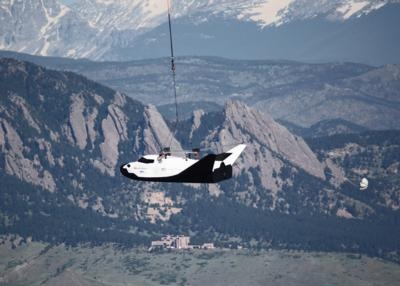Fri, Jun 08, 2012
Vehicle Designed To Transport Astronauts To ISS
The preliminary design review (PDR) of the design, architecture and performance of the Dream Chaser orbital crew vehicle has been completed by Sierra Nevada Corporation (SNC) Space Systems. This marks a milestone in the company's effort to develop transportation for astronauts to low Earth orbit and the International Space Station.

SNC is one of several companies working to develop commercial crew transportation capabilities under the Commercial Crew Development Round 2 (CCDev2) agreement with NASA's Commercial Crew Program (CCP). The goal is to help spur innovation and development of new spacecraft and launch vehicles from the commercial industry to develop safe, reliable and cost-effective capabilities to transport astronauts to low Earth orbit and the space station. The Dream Chaser is designed to carry as many as seven astronauts to space. It is the only spacecraft under CCDev2 that uses wings and is designed to land on a conventional runway.
"As CCP's partners meet these critical milestones, we are moving in the right direction in our combined effort to advance commercial capabilities that could eventually transport NASA astronauts," NASA CCP Program Manager Ed Mango said.
This marks the 17th milestone to be completed by SNC during CCP's initial two development phases. The PDR included a review of the entire orbital flight program, including the Dream Chaser spacecraft, and associated mission and ground systems. The company also reviewed the spacecraft's compatibility with its initial launch vehicle, the United Launch Alliance Atlas V rocket. "Our program includes 12 industrial partners, 7 NASA Centers and 3 universities from over 20 states who helped us achieve two major program milestones this week. With the completion of PDR and the beginning of our vehicle's flight test program, the Dream Chaser Program has now entered the next phase of its development. We are proud to be included with the other CCDev companies in developing a US crew capability to low earth orbit," said Mark Sirangelo, Corporate Vice President and head of SNC's Space Systems.
The final PDR board meeting was conducted shortly after the company successfully completed a captive-carry test of its full-scale Dream Chaser test flight vehicle May 29. The flight met all its test goals and moved the program a step closer to preparing the vehicle for an autonomous approach and landing test scheduled for later this summer. All of NASA's industry partners, including SNC, continue to meet their established milestones in developing commercial crew transportation capabilities.
NASA also is developing the Orion spacecraft and Space Launch System (SLS), a crew capsule and heavy-lift rocket that will provide an entirely new capability for human exploration beyond low Earth orbit. Designed to be flexible for launching spacecraft for crew and cargo missions, SLS and Orion will expand human presence beyond low Earth orbit and enable new missions of exploration across the solar system. (NASA image Dream Chaser during captive-carry test)
More News
Circle To Runway (Runway Number) Used by ATC to inform the pilot that he/she must circle to land because the runway in use is other than the runway aligned with the instrument appr>[...]
Aero Linx: National Aviation Safety Foundation (NASF) The National Aviation Safety Foundation is a support group whose objective is to enhance aviation safety through educational p>[...]
At Altitude Of About 250-300 Ft Agl, The Airplane Experienced A Total Loss Of Engine Power On November 6, 2024, at 1600 central standard time, a De Havilland DHC-1, N420TD, was inv>[...]
From 2009 (YouTube Edition): Three Hour Flight Was 'Flawless' -- At Least, Until Mother Nature Intervened For anyone who loves the aviation business, this was a VERY good day. Afte>[...]
Also: AMA Names Tyler Dobbs, More Falcon 9 Ops, Firefly Launch Unsuccessful, Autonomous F-16s The Air Force has begun ground testing a future uncrewed jet design in a milestone tow>[...]
 ANN's Daily Aero-Term (05.05.25): Circle To Runway (Runway Number)
ANN's Daily Aero-Term (05.05.25): Circle To Runway (Runway Number) ANN's Daily Aero-Linx (05.05.25)
ANN's Daily Aero-Linx (05.05.25) NTSB Prelim: De Havilland DHC-1
NTSB Prelim: De Havilland DHC-1 Classic Aero-TV: The Boeing Dreamliner -- Historic First Flight Coverage
Classic Aero-TV: The Boeing Dreamliner -- Historic First Flight Coverage Airborne-NextGen 05.06.25: AF Uncrewed Fighters, Drones v Planes, Joby Crew Test
Airborne-NextGen 05.06.25: AF Uncrewed Fighters, Drones v Planes, Joby Crew Test



